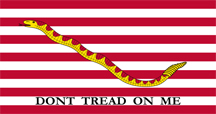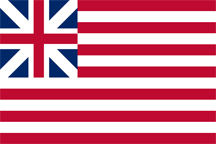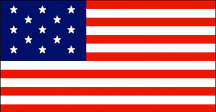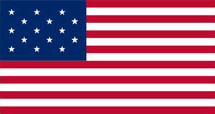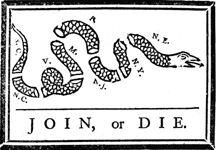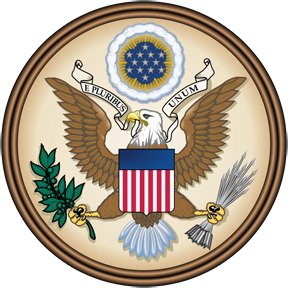Four Early Flags
Gadsden’s Flag, 1775
This was the first American flag, designed specifically as a Navy jack by Christopher Gadsden, the Congressional delegate from South Carolina.
Anyone could read its message: When pieced together into a living organism, the colonies could come alive like the deadly reptile found only in America, the Eastern diamondback rattler.
The rattlesnake—with thirteen symbolic rattles—plus the cautionary motto, probably were inspired by Benjamin Franklin’s famous political cartoon of 1754 (see below).
Grand Union Flag, 1775
The colors and design, especially the British Union in the canton, reflected the prevailing sentiment in the Second Continental Congress that a majority of the delegates still hoped for reconciliation with the mother country.
The two white crosses in the British Union represented the kingdoms of England and Scotland. The thirteen alternating red and white stripes stood for the thirteen colonies of New England and the southern Atlantic Coast.
Hopkinson’s 13-Star Flag, 1777
The Flag Act of 14 June 1777, retained the thirteen alternating red and white stripes of the Grand Union Flag, but replaced the British Union symbol in the blue canton with thirteen white stars—”a new Constellation.” The arrangement of stars, and the proportion of the canton to the field of stripes was still unspecified.
This design, first known as the “Marine Flag,” was used for seventeen years without revision, to identify ships of the Navy, and American merchant ships after the Navy was disbanded.
Fifteen-Star Flag, 1794
Continental Colors
The so-called “Continental Colors,”[1]In Noah Webster’s first dictionary, the Compendious Dictionary of the English Language, published in 1806, “flag” and “colors” were synonyms, while “colors” … Continue reading authorized by the Flag Act of 1794, consisted of fifteen red and white stripes, with a blue canton containing fifteen white five-pointed stars or mullets arranged in unspecified patterns. The number of points on the stars was still a matter of choice.
Together they accounted for the thirteen original Colonies plus the two states that had recently been admitted to the Union, Vermont in 1791 and Kentucky in 1792. But change was a vital element in the nation’s destiny, and its flag would have to follow.
During the twenty-four-year interval between the Flag Act of 1794 and the one of 1818, five more states were admitted: Tennessee, Ohio, Louisiana, Indiana, and Mississippi. Congress added the first two in 1796 and 1803, respectively, whereupon a number of unauthorized 17-star/17-stripe flags were manufactured, including some by order of government agencies. In December 1803, for example, the commander at Fort Dearborn, a new garrison on the site of the future city of Chicago, Illinois, sent an order to the Schuylkill Arsenal in Philadelphia, for “Five Flags of about 9 feet by 6 with the Eagle, 17 stars by 17 stripes made of buntin,”[2]Letters Received, Coxe-Irvine (circa 1797-1842), Record Group 92, Box 47, National Archives; it is cited in Grace Rogers Cooper, Thirteen-Star Flags: Keys to Identification (Washington, D.C.: … Continue reading for use by the Indian Department. Presumably “the eagle” referred to the central element of the Great Seal of the United States, which would have been painted in oils on the blue canton, with 17 stars either placed around the eagle, or else in the circle of dark-bordered clouds and golden sunlight.
Franklin’s “Join, or Die”
Benjamin Franklin had a knack for expressing his opinions incisively. With this little sketch he created one of the first political cartoons in American journalism. With this drawing of a dissected snake Franklin evoked the then-common superstition that a snake that had been cut into pieces would return to life if they were put back together before sunset. With New England at its head, the reptile’s seven remaining segments are New York, New Jersey, Rhode Island, Massachusetts, Virginia, North Caroline, and South Carolina.
He published it in his newspaper, the Pennsylvania Gazette, on 9 May 1754, along with an editorial supporting the need for the “present disunited State of the British Colonies” to join together for their own survival in order to resist the efforts of French and Indian militants to control the land west of the Appalachians. As if to test the truth of the old superstition about the revivability of reptiles, the image was restored for various purposes throughout the post-Revolutionary Era and even, with suitable emendations, on both sides during the Civil War.
Instruments of Exploration and Conquest
At the close of the 18th century, this flag bearing the Cross of St. Andrew was the Spanish military flag, as well as the flag of Spain’s overseas territories. With its bold, simple but unique icon, it bore the authority of more than four centuries of Spanish national tradition. In 1796, Auguste Chouteau, a prominent trader on the lower Missouri, delivered five of them to the Company of the Upper Missouri in behalf of the territorial government, to be given to the Little Osage, Kansa, Otoe, Omaha and Ponca Indian tribes.[3]Baron de Carondelet, Governor of Spanish Louisiana, to Zenon Trudeau, Lieutenant Governor of Spanish Louisiana, 11 May 1796; Trudeau to Carondelet, 22 May 1796. A. P. Nasatir, Before Lewis and Clark: … Continue reading More complex designs, including portions of the royal coat of arms of Charles III, who ruled Spain from 1759 until 1788, might also have been seen along the Missouri by Lewis and Clark.
Flags are keys to their owners’ identities—essentially non-verbal enshrinements of historical verities and mystical secrets. Their emblematic shapes and colors transcend literal references and imbue the surrounding space—place, vicinity, or region—with a specific civil or religious authority. During the long era of geographical exploration and discovery by land and sea that began in Europe in the early fifteenth century, the mere hoisting of a banner on a flagstaff was sufficient to claim ownership of a land and its natural resources, as well as to summon the allegiance of all of its inhabitants to a new ruler or government. Of course, a flag’s symbolism had to be explained to the people’s leaders, and that was an important part of an explorer’s job.
Globally, the Age of Exploration was well past its zenith by the beginning of the nineteenth century. The next step was to take precise measurements with which discoveries and ownerships could be documented and published in reports and maps. In North American exploration the overriding desire was to find and map the legendary waterway through the continent, which Thomas Jefferson was convinced would consist of an interlocking of the Missouri and Columbia Rivers, separated at their headwaters by a short portage. If there really was a transcontinental waterway between the Atlantic and Pacific oceans, and if it were viable for large boats, it would provide the fastest and cheapest imaginable route between the major markets of Europe and those of the Orient. Moreover, the discovery would endow the nation with unlimited opportunities by launching it into the orbit of global power and influence.
The flags of England, France, Spain, and latterly Russia, had already been committed to that mission for several decades, but it was Meriwether Lewis, William Clark and the Corps of Discovery, who wakened their countrymen from that long, apocryphal dream. A key item in Lewis’s long list of needs for the journey would have been a large supply of American flags, to be flown on their boats, over their camps, and at their council sites. Unfortunately, known records of the enterprise contain no details about the flags they carried, nor any clear indication of how many they carried of each of three sizes.
That void may be a consequence of the fact that from the Revolution until the middle of the 19th century, the flag now known worldwide by its stars and stripes (see Fifteen-Star Flag, 1794) was not yet recognized as a symbol of the United States as a whole. Indeed, the full power of the American flag as the sacred symbol of our “civil religion”[4]Ellis M. West, “A proposed neutral definition of civil religion,” Journal of Church & State, 22:1 (Winter, 1980), 39. grew but slowly during the first century-and-a-half following the Revolution, and in some respects is still evolving. It was nearly mid-century before Francis Scott Key’s stirring song began to be thought of in some quarters as potentially our national theme song, and it would be another 123 years before it officially became our national anthem.
As to the flag itself, after the congressional legislation of 1818, which declared that a star was to be added for each new state on the Fourth of July following its admittance, no further changes in design were made until 1912, when President Howard Taft, by Executive Order, adopted general proportional ratios and a standard arrangement of stars, but the specifics were delayed by many more years. The choice of shades of red, white and blue, for example, was subjective until 1934, and the policy was updated in 1981 by the General Services Administration, which assigned definitive RGB values to dark red (191,10,48), white (255,255,255), and navy blue (0,40,104), although that prescription applies only to flags made by or for the United States Government. A step toward a code of etiquette for the display and treatment of the flag was taken in 1923, but another nineteen years elapsed before the first Federal Flag Code (Public Law 829; Chapter 806) was enacted in 1942. It recognized the existence of the Pledge of Allegiance, which had been introduced (by the Reverend Francis Bellamy, a socialist!) into the public schools beginning in 1892; the words “under God” were added in 1954, at the height of the Cold War with Russia. Section 176-j of the Code as amended by Congress on 7 July 1976, states that “The flag represents a living country and is itself considered a living thing.” With that declaration, the apotheosis of the American flag would seem to be virtually complete.
Great Seal of the United States
This seal consists of the symbolic elements representing the origins and the Founding Fathers’ ideals of the United States of America. If Lewis and Clark had carried any flags bearing this image, they could have used them as visual cues for a long story about the American nation. Even the colors are part of the message: red for hardiness and valor; white for purity and innocence; blue for vigilance, perseverance and justice.
In 1935, President Franklin Delano Roosevelt ordered both faces of the Great Seal placed on the reverse side of the one-dollar bill. Some years before that, the decision was made that a constellation of only 13 silver stars need appear in the crest above the eagle’s head.
Although the Continental Colors carried the authority of Congressional approval, it lacked the popular appeal and utility that some other formats held. The symbol that held the deepest meaning and inspiration for Americans was the figure of George Washington, “The Father of Our Country” and Americans’ “late fellow citizen” whose “unclouded brightness of . . . Glory will illuminate future ages.”
Similarly inspiring were personifications of Columbia and Liberty, which the French government celebrated in 1886 with the gift they called “Liberty Enlightening the World,” soon familiarly known around the globe as the Statue of Liberty. Another was “America,” a woman clad in a Roman, carrying a shield decorated with an eagle, and accompanied by an American Indian. “America” was sometimes grouped with three similar figures to represent the four continents.
But the favored symbol of America was the powerful, independent and imposing bald eagle Haliaeetus leucocephalus, or “white-headed sea-bird”).[5]Guenter, p. 39. Benjamin Franklin, who was a member of the first committee, proposed that the wild turkey was more suitable as a symbol of peace. It was not strictly an American icon, but during the Federalist Era it was the most conspicuous wild creature to be seen on the banks of the major watercourses that were the preferred travel routes between the Atlantic Coast and the Mississippi River.
Between 1776 and 1782, three successive Congressional committees worked on a design for a Great Seal of the United States. The third of the three proposals was the first to include an eagle. But it was Charles Thompson, the Secretary of Congress and the creator of the final design based on the committees’ recommendations, who made the bald eagle the dominant symbol. His design was approved by the Congress of the Confederation on 20 June 1782. In Thompson’s “armorial device” the eagle, together with its heraldic appurtenances, reflected “the beliefs and values that the Founding Fathers attached to the new nation and wished to pass on to their descendants.”[6]U.S. Department of State, Bureau of Public Affairs, The Great Seal of the United States, p. 7. A pdf of this 18-page history of the Seal may be downloaded free of charge from … Continue reading On the eagle’s breast is an escutcheon, or shield, containing thirteen alternating red and white vertical stripes called Pieces, which represent the thirteen original states. The Pieces are bound together at their upper ends by the blue bar or Chief, which represents the Congress.
In its left talon the eagle clutches a bundle of thirteen arrows signifying strength in unity, and preparedness for war. Its right talon grasps an olive branch with 13 leaves.[7]According to the Old Testament (Genesis 8:6-12), in order to learn whether the flood had receded or not, Noah twice launched a dove from the Ark. The first time it returned, exhausted, without any … Continue reading The eagle’s head is turned to its right, indicating a positive desire for peace. It clenches in its beak a scroll bearing the Latin motto E pluribus unum—”From many, one.” Above its head, in the 1782 version of the Seal, is a Crest consisting of the “new constellation” of thirteen silver five-pointed stars shine through a circle of dark-rimmed clouds. Through the clouds a Glory of golden sunlight shines upon the rising eagle.
Notes
| ↑1 | In Noah Webster’s first dictionary, the Compendious Dictionary of the English Language, published in 1806, “flag” and “colors” were synonyms, while “colors” was separately defined as “a banner, flag, streamer, victory, honor.” |
|---|---|
| ↑2 | Letters Received, Coxe-Irvine (circa 1797-1842), Record Group 92, Box 47, National Archives; it is cited in Grace Rogers Cooper, Thirteen-Star Flags: Keys to Identification (Washington, D.C.: Smithsonian Institution Press, 1973), 16. “Buntin” (also buntine, or bunting) denoted a thin but strong worsted wool fabric, which was especially suitable for flags. Because bunting was more cheaply produced in England, it was imported into the U.S. until 1865. It was manufactured in strips of red, white, and blue in various widths, which were sewed together in the proper order and length. Stars, often made of light-weight muslin, were stitched onto the blue canton of the Continental Colors. The eagle, if used instead of stars, could have been embroidered, appliqued, or painted on the blue canton in oils. Today, bunting refers to any collection of flags, banners, pennants, etc., that are strung together for decorative purposes. Scot M. Guenter, The American Flag, 1777-1924: Cultural Shifts from Creation to Codification (Madison, New Jersey: Fairleigh Dickinson University Press, 1990), 89-91. |
| ↑3 | Baron de Carondelet, Governor of Spanish Louisiana, to Zenon Trudeau, Lieutenant Governor of Spanish Louisiana, 11 May 1796; Trudeau to Carondelet, 22 May 1796. A. P. Nasatir, Before Lewis and Clark: Documents illustrating the History of the Missouri, 1785-1804, Bison Book Edition, 2 vols. (Lincoln: University of Nebraska Press, 1990), 2:426, 430. The Cross of Burgundy still flies as a historical symbol over San Juan National Historic Site in Puerto Rico, and at Castillo de San Marcos National Monument in St. Augustine, Florida. |
| ↑4 | Ellis M. West, “A proposed neutral definition of civil religion,” Journal of Church & State, 22:1 (Winter, 1980), 39. |
| ↑5 | Guenter, p. 39. Benjamin Franklin, who was a member of the first committee, proposed that the wild turkey was more suitable as a symbol of peace. |
| ↑6 | U.S. Department of State, Bureau of Public Affairs, The Great Seal of the United States, p. 7. A pdf of this 18-page history of the Seal may be downloaded free of charge from http://www.usa.gov/About/Great_Seal.shtml (retrieved 11 May 2009). |
| ↑7 | According to the Old Testament (Genesis 8:6-12), in order to learn whether the flood had receded or not, Noah twice launched a dove from the Ark. The first time it returned, exhausted, without any sign of having found land. The second time, it brought back an olive leaf, which proved that the floodwaters had receded, and green mountain tops were again exposed. Later, the olive branch became a popular ancient Greek symbol of peace, safety and good will. In the current version of the Seal, the olive branch bears thirteen olives, obviously signifying the thirteen original colonies. |
Experience the Lewis and Clark Trail
The Lewis and Clark Trail Experience—our sister site at lewisandclark.travel—connects the world to people and places on the Lewis and Clark Trail.
Discover More
- The Lewis and Clark Expedition: Day by Day by Gary E. Moulton (University of Nebraska Press, 2018). The story in prose, 14 May 1804–23 September 1806.
- The Lewis and Clark Journals: An American Epic of Discovery (abridged) by Gary E. Moulton (University of Nebraska Press, 2003). Selected journal excerpts, 14 May 1804–23 September 1806.
- The Lewis and Clark Journals. by Gary E. Moulton (University of Nebraska Press, 1983–2001). The complete story in 13 volumes.
